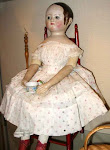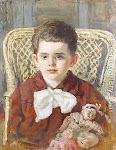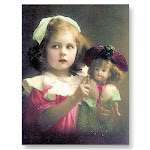
During the 18th century, milliners took the hat-making art out of the home and established the millinery profession. Today, a ‘milliner’ defines a person associated with the profession of hat making. In the 18th century however, a millinery was more of a stylist.

 Hats were extremely important during the Regency era and no woman, whether servant or mistress, would dream of being seen outside the home without something on her head!
Hats were extremely important during the Regency era and no woman, whether servant or mistress, would dream of being seen outside the home without something on her head!

 The millinery trade rapidly brought hat-making to the level of a personalized art form. Whether it was an upscale boutique in Paris, or a small shop on the plains of the Midwest, the milliner designed hats specifically for each individual customer, turning out creations that emphasized or exaggerated the personal characteristics of the wearer.
The millinery trade rapidly brought hat-making to the level of a personalized art form. Whether it was an upscale boutique in Paris, or a small shop on the plains of the Midwest, the milliner designed hats specifically for each individual customer, turning out creations that emphasized or exaggerated the personal characteristics of the wearer.
 Straw hat making was a cottage industry and gave work to hundreds of women. The pay, as for other female workers, was low.
Straw hat making was a cottage industry and gave work to hundreds of women. The pay, as for other female workers, was low.
Department store managers were only starting to realize the value of employing women in retail sales -especially in dealing with a store's female clientele. Women were attributed with having more tact and accuracy in serving customers needs, and the fitting of new garments was greatly simplified.

As a result, millinery shops, which dealt almost entirely in ladies hats, gloves and other fine and fancy accessories, were to the ladies what the barbershop was to the men.
 In earlier centuries, millinery was an important profession given the high demands for hats for daily wear, and formal occasions. It was additionally a profession that was held by many women; “hats made by women for women.” Being a milliner was thought decent and respectable employment for ladies of the 18th, 19th , and 20th century.
In earlier centuries, millinery was an important profession given the high demands for hats for daily wear, and formal occasions. It was additionally a profession that was held by many women; “hats made by women for women.” Being a milliner was thought decent and respectable employment for ladies of the 18th, 19th , and 20th century.

 The term millinery is also used when referring to decorations of pre-made hats, such as the artful bow, the feather or ribbon added to a hat, is considered millinery.
The term millinery is also used when referring to decorations of pre-made hats, such as the artful bow, the feather or ribbon added to a hat, is considered millinery.
 Even indoors married women and old spinsters would wear soft caps. As most women wore bonnets or capotte hats during the Regency, daytime hair styles were rather simple.
Even indoors married women and old spinsters would wear soft caps. As most women wore bonnets or capotte hats during the Regency, daytime hair styles were rather simple.
 Bonnets differed from hats in having soft crowns but a stiff brim, sometimes made of straw. Caps were soft, made of fabric and often worn under hats.
Bonnets differed from hats in having soft crowns but a stiff brim, sometimes made of straw. Caps were soft, made of fabric and often worn under hats.
 In a time that frowned upon women holding jobs and working outside of the home, millinery shops were one of the few economic enterprises that could be owned, operated and frequented by women with no fear of damage to their social respectability.
In a time that frowned upon women holding jobs and working outside of the home, millinery shops were one of the few economic enterprises that could be owned, operated and frequented by women with no fear of damage to their social respectability.
 The early 19th century saw the fledgling beginning of the modern fashion designer. Up to this point a woman went to the dressmaker for her gowns, the milliner for her hats, gloves and other accessories were purchased from other shops. The fashion designer, on the other hand, offered the whole package.
The early 19th century saw the fledgling beginning of the modern fashion designer. Up to this point a woman went to the dressmaker for her gowns, the milliner for her hats, gloves and other accessories were purchased from other shops. The fashion designer, on the other hand, offered the whole package.  Traditionally a woman’s occupation, the milliner not only created hats or bonnets to go with costumes but also chose the laces, trims and accessories to complete an ensemble.
Traditionally a woman’s occupation, the milliner not only created hats or bonnets to go with costumes but also chose the laces, trims and accessories to complete an ensemble.

 Hats were extremely important during the Regency era and no woman, whether servant or mistress, would dream of being seen outside the home without something on her head!
Hats were extremely important during the Regency era and no woman, whether servant or mistress, would dream of being seen outside the home without something on her head!

 The millinery trade rapidly brought hat-making to the level of a personalized art form. Whether it was an upscale boutique in Paris, or a small shop on the plains of the Midwest, the milliner designed hats specifically for each individual customer, turning out creations that emphasized or exaggerated the personal characteristics of the wearer.
The millinery trade rapidly brought hat-making to the level of a personalized art form. Whether it was an upscale boutique in Paris, or a small shop on the plains of the Midwest, the milliner designed hats specifically for each individual customer, turning out creations that emphasized or exaggerated the personal characteristics of the wearer.
 Straw hat making was a cottage industry and gave work to hundreds of women. The pay, as for other female workers, was low.
Straw hat making was a cottage industry and gave work to hundreds of women. The pay, as for other female workers, was low.
Department store managers were only starting to realize the value of employing women in retail sales -especially in dealing with a store's female clientele. Women were attributed with having more tact and accuracy in serving customers needs, and the fitting of new garments was greatly simplified.

As a result, millinery shops, which dealt almost entirely in ladies hats, gloves and other fine and fancy accessories, were to the ladies what the barbershop was to the men.
 In earlier centuries, millinery was an important profession given the high demands for hats for daily wear, and formal occasions. It was additionally a profession that was held by many women; “hats made by women for women.” Being a milliner was thought decent and respectable employment for ladies of the 18th, 19th , and 20th century.
In earlier centuries, millinery was an important profession given the high demands for hats for daily wear, and formal occasions. It was additionally a profession that was held by many women; “hats made by women for women.” Being a milliner was thought decent and respectable employment for ladies of the 18th, 19th , and 20th century.

 The term millinery is also used when referring to decorations of pre-made hats, such as the artful bow, the feather or ribbon added to a hat, is considered millinery.
The term millinery is also used when referring to decorations of pre-made hats, such as the artful bow, the feather or ribbon added to a hat, is considered millinery.
 Even indoors married women and old spinsters would wear soft caps. As most women wore bonnets or capotte hats during the Regency, daytime hair styles were rather simple.
Even indoors married women and old spinsters would wear soft caps. As most women wore bonnets or capotte hats during the Regency, daytime hair styles were rather simple.
 Bonnets differed from hats in having soft crowns but a stiff brim, sometimes made of straw. Caps were soft, made of fabric and often worn under hats.
Bonnets differed from hats in having soft crowns but a stiff brim, sometimes made of straw. Caps were soft, made of fabric and often worn under hats.
 In a time that frowned upon women holding jobs and working outside of the home, millinery shops were one of the few economic enterprises that could be owned, operated and frequented by women with no fear of damage to their social respectability.
In a time that frowned upon women holding jobs and working outside of the home, millinery shops were one of the few economic enterprises that could be owned, operated and frequented by women with no fear of damage to their social respectability.
 The early 19th century saw the fledgling beginning of the modern fashion designer. Up to this point a woman went to the dressmaker for her gowns, the milliner for her hats, gloves and other accessories were purchased from other shops. The fashion designer, on the other hand, offered the whole package.
The early 19th century saw the fledgling beginning of the modern fashion designer. Up to this point a woman went to the dressmaker for her gowns, the milliner for her hats, gloves and other accessories were purchased from other shops. The fashion designer, on the other hand, offered the whole package.  Traditionally a woman’s occupation, the milliner not only created hats or bonnets to go with costumes but also chose the laces, trims and accessories to complete an ensemble.
Traditionally a woman’s occupation, the milliner not only created hats or bonnets to go with costumes but also chose the laces, trims and accessories to complete an ensemble.
< Edgar Degas... At the Milliner, 1881
Edgar Degas... At the Milliner, 1881
Straw hats could be trimmed only with flowers and ribbons for summer use. At other times straw hats where covered with silk, taffeta or similar material, showing nothing of the foundation material at all.
 Over the centuries, hats came to the forefront of the millinery trade and by the 19th century most Millinery shops were in essence ladies hat shops with gloves and other fine accessories pushed to the smaller side counters as a relative afterthought. Throughout the history of fashion, hats served as the status symbol that delineated the line between the social classes through their use of material, decoration, and utility... (or the lack of it).
Over the centuries, hats came to the forefront of the millinery trade and by the 19th century most Millinery shops were in essence ladies hat shops with gloves and other fine accessories pushed to the smaller side counters as a relative afterthought. Throughout the history of fashion, hats served as the status symbol that delineated the line between the social classes through their use of material, decoration, and utility... (or the lack of it).
 Edgar Degas... At the Milliner, 1881
Edgar Degas... At the Milliner, 1881
Straw hats could be trimmed only with flowers and ribbons for summer use. At other times straw hats where covered with silk, taffeta or similar material, showing nothing of the foundation material at all.
 Over the centuries, hats came to the forefront of the millinery trade and by the 19th century most Millinery shops were in essence ladies hat shops with gloves and other fine accessories pushed to the smaller side counters as a relative afterthought. Throughout the history of fashion, hats served as the status symbol that delineated the line between the social classes through their use of material, decoration, and utility... (or the lack of it).
Over the centuries, hats came to the forefront of the millinery trade and by the 19th century most Millinery shops were in essence ladies hat shops with gloves and other fine accessories pushed to the smaller side counters as a relative afterthought. Throughout the history of fashion, hats served as the status symbol that delineated the line between the social classes through their use of material, decoration, and utility... (or the lack of it). 












































.jpg)
































































Siempre he pensado que es una pena que ya no se usen los sombreros. Tanto mujeres como hombres. Son fascinantes. La moda de esa época, no sería cómoda, pero era cautivadora. Una dama, con esos sombreros, y esos vestidos con metros de preciosas telas... Me encanta verlo en las películas.
ReplyDeleteGracias Marta.
Un beso.
I agree totally. Despite the confining clothes, women exuded femininity and charm. I just love that era.
ReplyDeleteThank you Alberto
Great post, Marta! Your articles are always informative. Thanks for sharing!
ReplyDeleteFabulous blog!
ReplyDeleteThank you for visiting me, I have added you to my Creative Places list on my blog.
Sandra Evertson
What a beautiful and informative post, Marta. My hat's off to you! Thank you so much.
ReplyDeleteZwee!!!!!!!
Another wonderful informative article Marta,
ReplyDeletethank you,
I love your website!!! very inspirational to me and all my life long love of dolls!
ReplyDeleteHello,
ReplyDeletewhere can I find the large print of the painting of the girls playing with their dolls. I would love to have a copy of that print. Do you know where I can order it?
Thank you Shannon...I will be posting again in the coming weeks, I have been away for awhile.
ReplyDeleteI don't remember exactly where I found that image...I spend many hours on the internet looking for images that I can use and I know I was delighted to find such a fitting one. Tthank you for your comments.
Bisous
Marta